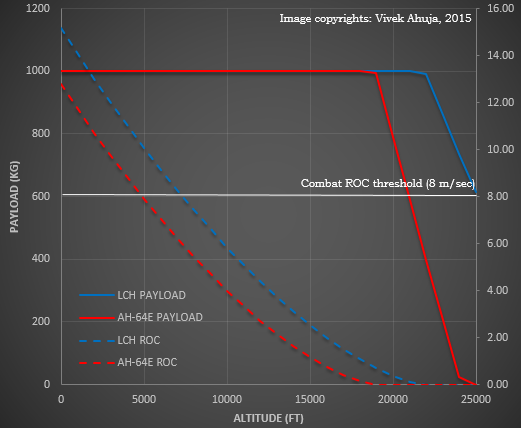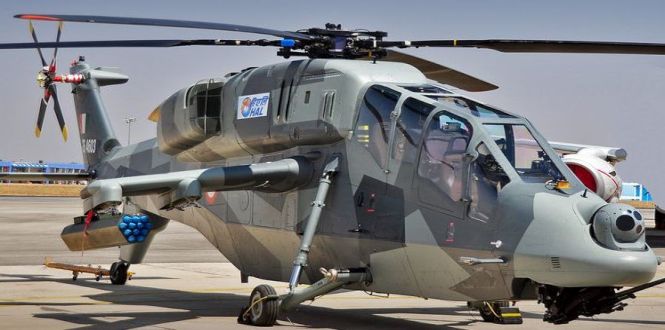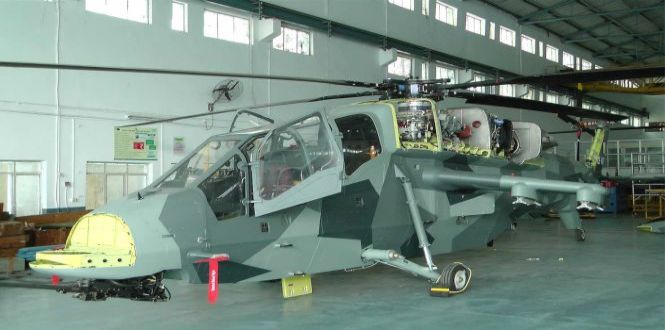Why the Apache is a brute and LCH is elegant
We will take the LCH and the Apache and put an identical payload of 1,000 kg on them. Note that we have increased the payload here from 500 kg to 1000 kg for this analysis as opposed to that done for the Z-10. The reasoning will simple: both the LCH and the Apache can haul 500 kg through the high Himalayas. However, to get an idea of different performances, we are getting more realistic and putting a higher payload. In reality, with about 200 kg of crew and around 300 kg of fuel, the effective payload of weapons is only 500 kg. We will run both helicopters through a simulation model where we subject them to altitude variations and see how it affects their rate-of-climb capabilities while in hover, out of Ground Effect conditions. The rate-of-climb (ROC, measured here in meters/second) is a true measure of the maneuvering capability of an attack helicopter. Typically, a ROC of 0.5 m/sec is used to evaluate service ceiling conditions. A ROC of 2.5 m/sec is typically the bare minimum for combat conditions. For a helicopter in high mountains to be truly maneuverable, it may need somewhere in the range of 2.5 to 8 m/sec vertical ROC equivalent in power capacity. Of course, beyond a certain altitude, the helicopter may not be able to fly with the 500 kg payload, let alone providing additional power for high ROC. So we will also see where those limits are for the LCH and the Z-10.
The focus of this analysis is on a preliminary aerodynamic and propulsive standpoint. The analysis is done using simulation tools that integrate payload capacities and typical rate-of-climb requirements with a preliminary rotary aerodynamics model and a simple propulsion module. When coupled with an atmospheric simulator for the Himalayas, the performance of each helicopter type can be predicted and compared. Furthermore, the models allow for the performance analysis in Ground Effect conditions. The Ground Effect conditions are encountered when the helicopters are hovering very close to the ground and serves to work as a performance multiplier with regard to power needed in lifting a certain payload.
The models do not compensate for transmission limitations for the power, which means that the analysis is idealized wherein power generated is power available. This is, of course, not encountered in practice, but works well for high-altitude conditions where power available is almost always less than the transmission limits. At lower altitudes, the performance of the various designs must be assumed to be ideal, rather than restricted from transmission and structural limitations. For example, the maximum rate-of-climb (ROC) values obtained from this simulator for sea-level (SL) conditions will typically be higher than what is allowed by other limitations. However, such removal of limitations is required in order to compare the various contenders at the same performance benchmarks.
Data for this analysis is obtained from the manufacturers via open-sources. No proprietary information is shared here. Unless where cited, the analysis results are to be considered proprietary of the author. See remarks for details.
LCH versus the Apache:
The hover performance is evaluated at altitudes varying from 0 ft (SL) to 25,000 ft. Altitudes in the Himalayan Mountains regularly require flights above 10,000 ft and often up to 22,000 ft. The data is presented for the LCH and the Apache for payload and available maximum ROC capability versus altitude. A threshold ROC line is shown for the reference 8 m/sec combat ROC.
http://thebetacoefficient.blogspot.in/2015/04/why-apache-is-brute-and-lch-is-elegant.html
To read further go through the link and please thank Vivek Ahuja for this analysis.
.......................................................................
This analysis however do not include the massive difference in survivability, firepower and avionics to name a few.
Survivability - Apache's crew cabin and rotor blades can survive direct hits from 23mm which is a very powerful cartridge and also one the most widely used in AAA. Same goes for Eurocopter Tiger and A/T-129 which belong to same weight class as LCH.
LCH being a light chopper is not designed for to be in the thick of the AAA fire and can sustain direct hits from 12.7mm which is good but not exactly the world beater. So, it is quite evident that HAL is not yet there in terms of material science.
Firepower - Not counting the quickly expandable missiles and rockets, turret guns are the mainstay weapons of any attack chopper. Apache has huge lead on not just LCH but every single chopper out there.
M230 - 30x113mm, 1200 rounds
M621 - 20x102, estimated 320 rounds
Avionics - Don't just don't............
.................................................................................................
LCH belongs to a different design mindset than Apache or any other chopper out there. It can do high altitude missions with sufficient payload, has decent avionics and firepower and above all, it is cheap and can be procured in large numbers.
Do not foolishly expect an Indian AH-64D at quarter the price.




 Yeh man. Now you are talking the lingo.
Yeh man. Now you are talking the lingo.
 On 21 December 2009, a pair of U.S. Apaches attacked a British-held base in a
On 21 December 2009, a pair of U.S. Apaches attacked a British-held base in a  .
. and effectively employed their
and effectively employed their  in Iraq, despite the Apache being typically able to avoid such missiles
in Iraq, despite the Apache being typically able to avoid such missiles  .
.




